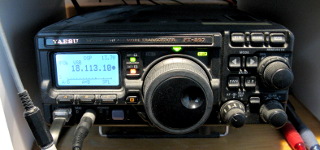
- HF / VHF / UHF, 100 / 50 / 20 W, all-mode transceiver
- With Inrad 2.0 kHz SSB filter
- Homebrew external power/signal meter
- Originally I had Yaesu's internal FNB-78 NiMH batteries in it
- Then I installed custom lithium-polymer batteries which were fantastic to use, but short-lived
- Now I have an external NiMH battery pack using low self-discharge NiMH D-cells
- When I still used the internal FNB-78 NiMH batteries, I built this homebrew discharge circuit to condition them
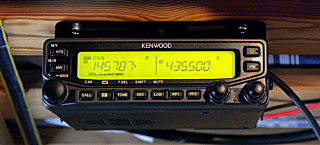
- VHF / UHF, 50 W FM transceiver
- Wide-band FM receive (+air band AM), covers also 23 cm
- Dual receive V/V, V/U, U/U
- Simultaneous transmission and reception V/U, U/V

- Manual HF antenna tuner
- 300 W power capability
- Dual-needle forward/reflected power meter with 30 / 300 W ranges (its backlight has been replaced by a white LED)
- Three coax lines and one balanced line output, tuned or bypassed
- With custom TX-request switch, requests a low-power carrier from the radio for tuning (interfaces to radio's ACC connector)
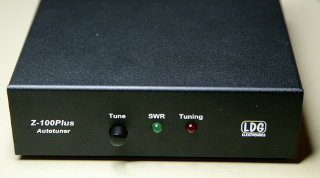
- Automatic HF antenna tuner for portable use
- 125 W power capability
- Custom modified for low TX-power tuning with the FT-897 (interfaces to radio's ACC connector)

- Provides automatic gain control and bandpass filtering for microphone audio
- 0 / 6 / 12 / 18 / 24 / 30 dB compression
- Compression is done at RF to avoid distortion, and even high settings don't sound absolutely horrid!
- With microphone level input and output, it is prone to hum-inducing ground loops when operated off the station 13.8 V supply—you DON'T want to know how I fixed that... (It could also be used with batteries, or a separate wall-wart transformer, either of which would immediately resolve the issue.)
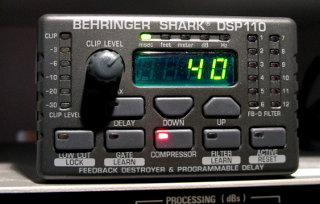
- This device is an audio "Swiss army knife": It contains a microphone preamp with gain control, it provides phantom power, it can convert between mic and line levels either way, as well as unbalanced to balanced like a "DI box".
- It includes an effective low-cut filter and noise gate—these make a cheap wireless mic sound much better in a PA application!
- The compressor seemed not to do anything, but measurements I made indicated that it does actually work—it just doesn't produce any nasty artefacts even with aggressive settings! However, I would not recommend this unit as a compressor for ham radio use regardless.
- Also includes an adjustable digital delay line. Besides making annoying echo effects, it could be used together with an analog compressor to obtain "zero attack time" compression.
- It has automatically adjusting feedback destroyer filters—not so useful for ham radio use, but they are somewhat effective in PA use. Nothing magical, though—place the mic directly infront of a loudspeaker, and you will get feedback, filters or not...
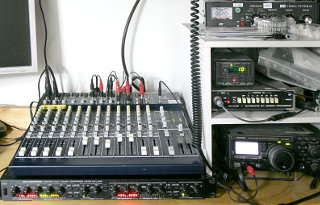
- Eight mono input channels with mic or line level input, phantom power, gain control, 3-band semi-parametric equalizer and Insert connectors
- Four stereo input channels with 4-band equalizer
- Two stereo output buses and two mono AUX-buses
- Custom modifications:
- CH1–CH8 AUX2 changed from post-fader to pre-fader (as instructed on page 24 of the User's Manual)
- CH1–CH4 Inserts changed from pre-Eq to post-Eq (read more about this mod)
- This is being put into use for mixing and routing audio between my microphones, radios, broadcast receiver, PC, speakers and headphones
- Underneath the mixer sits an Alesis 3630 dual channel compressor. For now I'm using it on the RX audio of the TM-V71E.
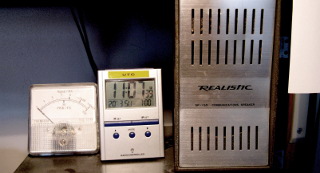
- Just a basic speaker, nothing more
- Sounds better than the radio's internal speaker
- You can see an identical (but differently branded) speaker in the Apollo 13 movie! :)
- Next to the speaker are the radio's external power/signal meter (homebrew) and a radio-controlled (DCF77) UTC clock
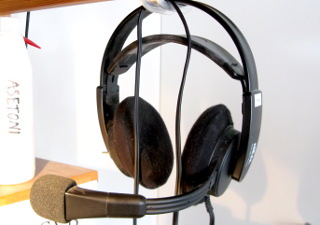
- Selectable HC-3 and HC-4 electret microphone capsules
- Good acoustic isolation in headphones
- Phase reversal switch in headphones actually helps sometimes!
- Quite comfortable to wear even extended periods of time
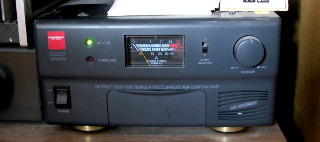
- 40 A switching power supply
- Voltage adjustable 5–15 V (who needs anything but 13.8 V?)
- Small, light and quiet (even without a fan mod), no RF noise
- With West Mountain Radio RIGrunner 4012 Powerpole distribution strip
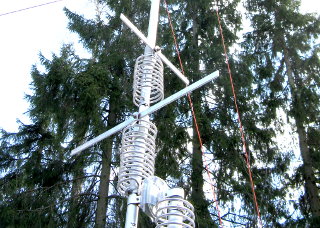
- Covers all bands from 80 m to 6 m
- Power capability is ridiculously high for my 100 W station
- Made of aluminum tubing, hose clamps and various scraps
- Doorknob capacitors were purchesed from eBay
- Fiberglass insulators are home-made
- More information on this antenna
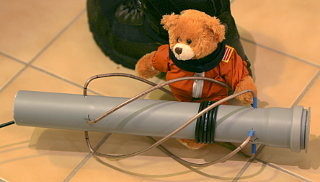
- Made of 3/16" Ni-Cu brake tubing and sewer pipe
- Right-hand circular polarization covering the entire sky for satellite use
- Enough radiation to the horizon to reach the local repeaters
- Fed through a Diamond MX-3000N triplexer (23 cm port unused)
- More information on these antennas and NEC2 simulation results
- There's also a program to make NEC2 models of QHAs
- Here's some more QHAs I have made
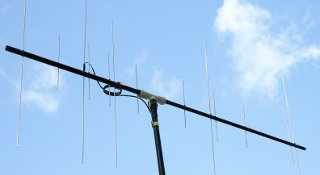
- Uses sections of a telescoping 8-meter fishing rod for mast and boom
- Five elements on 2 m and eight on 70 cm (dual band) or six on 2 m (monoband)
- Single 50-ohm feed by coax with a choke balun
- More information on these antennas, including dimensions
- I use these antennas with my Wouxun handheld (see below)
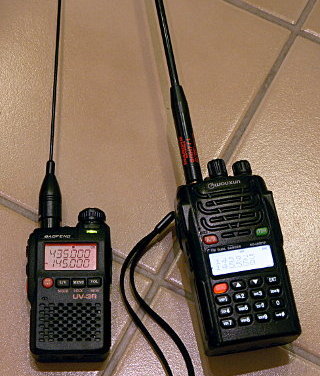
- Really tiny, with 2 W output on 2 m and 70 cm bands
- CTCSS, DCS, repeater shift, FM brodcast band reception
- With Nagoya NA-666 antenna: Quite impressive performance, actually
- Here is a modification to disable the annoying "Alarm" function!
Wouxun KG-UVD1P VHF/UHF Handheld
- 5 W output on 2 m and 4 W on 70 cm bands
- CTCSS, DCS, repeater shift, FM broadcast band reception
- With Diamond SRH-771 antenna for impressive looks
- Claims IP55 protection
Both radios are supported in Linux by CHIRP. Also, the UV-3R software (ver. 1.11) and the KG-UVD1P band limit software both install and run just fine under Wine. I used these to set the band limits to the Finnish ham band allocations, to prevent inadvertent out-of-band operation.
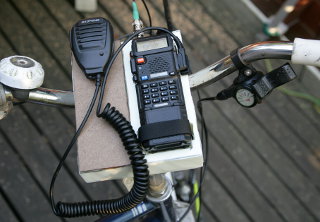
- 4 W output on 2 m and 70 cm
- With the 3800 mAh extra capacity battery and modified speaker mike
- With a vibration-isolating base for mounting onto my bicycle handle bars
- Feeding into a homebrew dual-band J-pole antenna mounted on the bicycle's front wheel fork
- This is also well supported in Linux by CHIRP. The newest version will also set band limits!
- Just one problem: Would a bicycle station be /Portable or /Mobile?
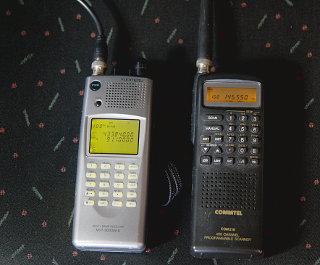
- Continuous frequency range 100 kHz – 2.0 GHz
- FM, WFM, AM, NAM, and USB, LSB and CW modes
- 1000 memories in 20 banks, 20 scan bands, 10 priority channels
- Bandercom M3-modification (improved scan speed, decreased intermod)
- Thanks to its USB mode, I've successfully used it to measure an amateur rocket's velocity based on Doppler shift
Commtel COM216 Scanning Receiver
- Continuous frequency range 25 MHz – 1.3 GHz
- FM, WFM and AM modes
- 400 memories in 10 banks + priority channel
- Similar to the Realistic PRO-26 and the Uniden UBC-3000XLT.
- Here is some more information on the COM216 and a brief user manual
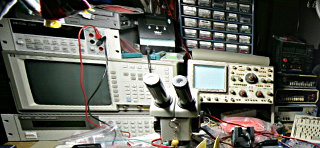
- Power supplies, multimeters, signal generators
- Oscilloscopes, spectrum analyzer, antenna analyzers
- Soldering station, stereo microscope
- Piles of junk
- etc...